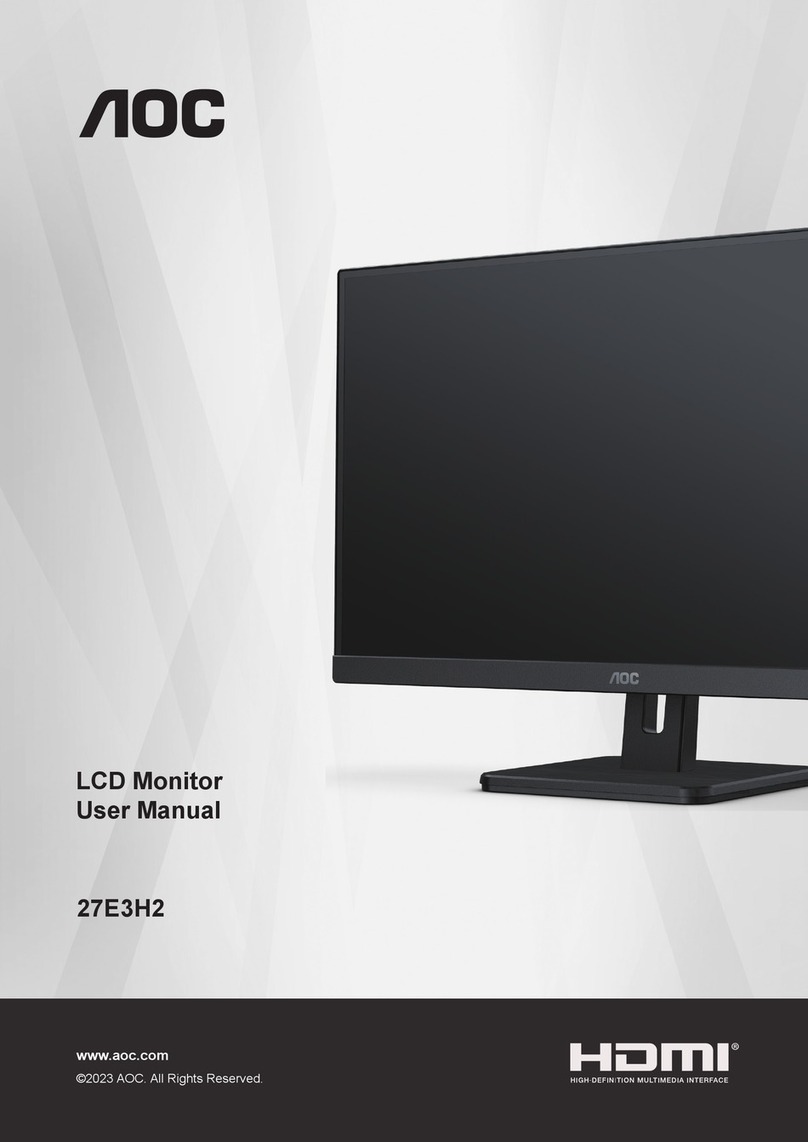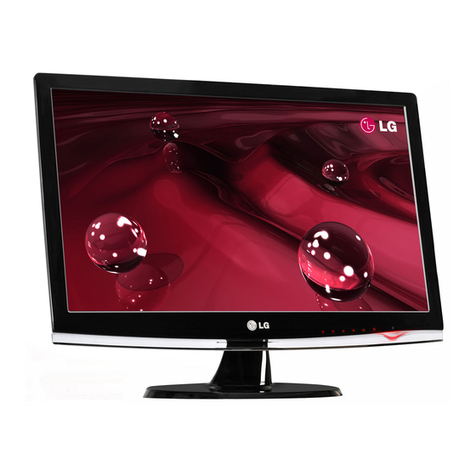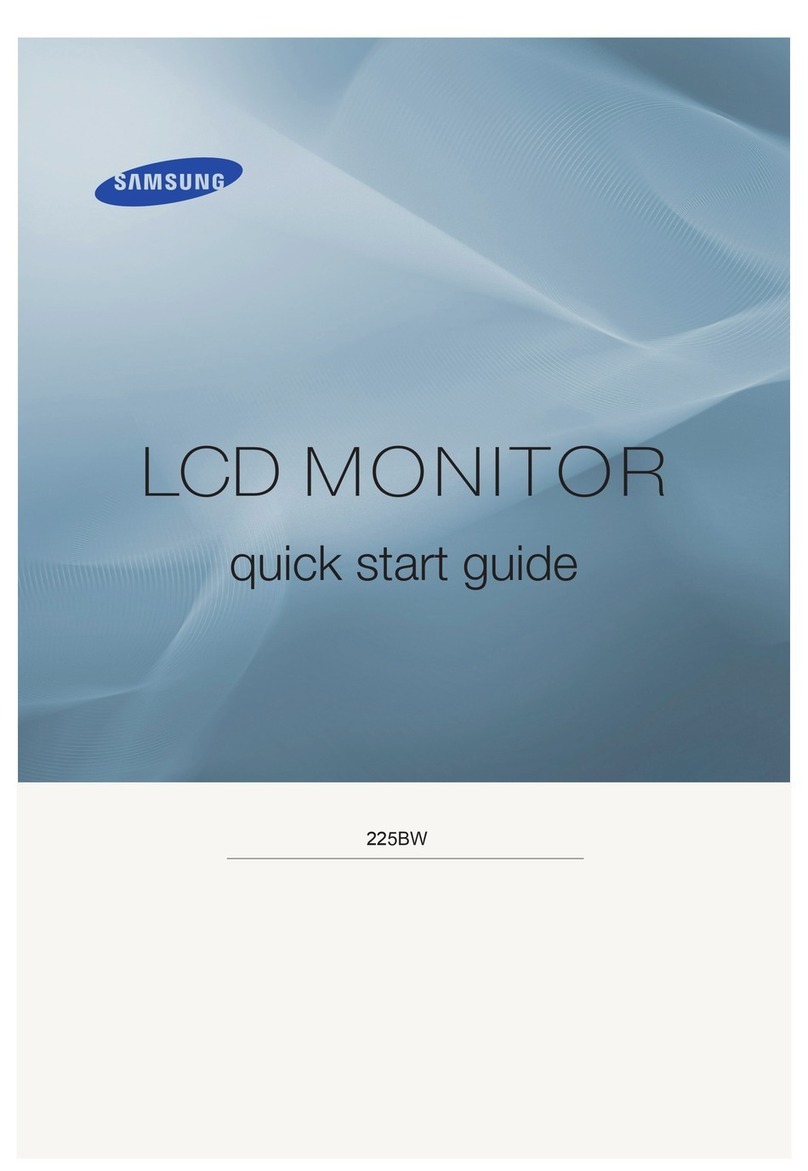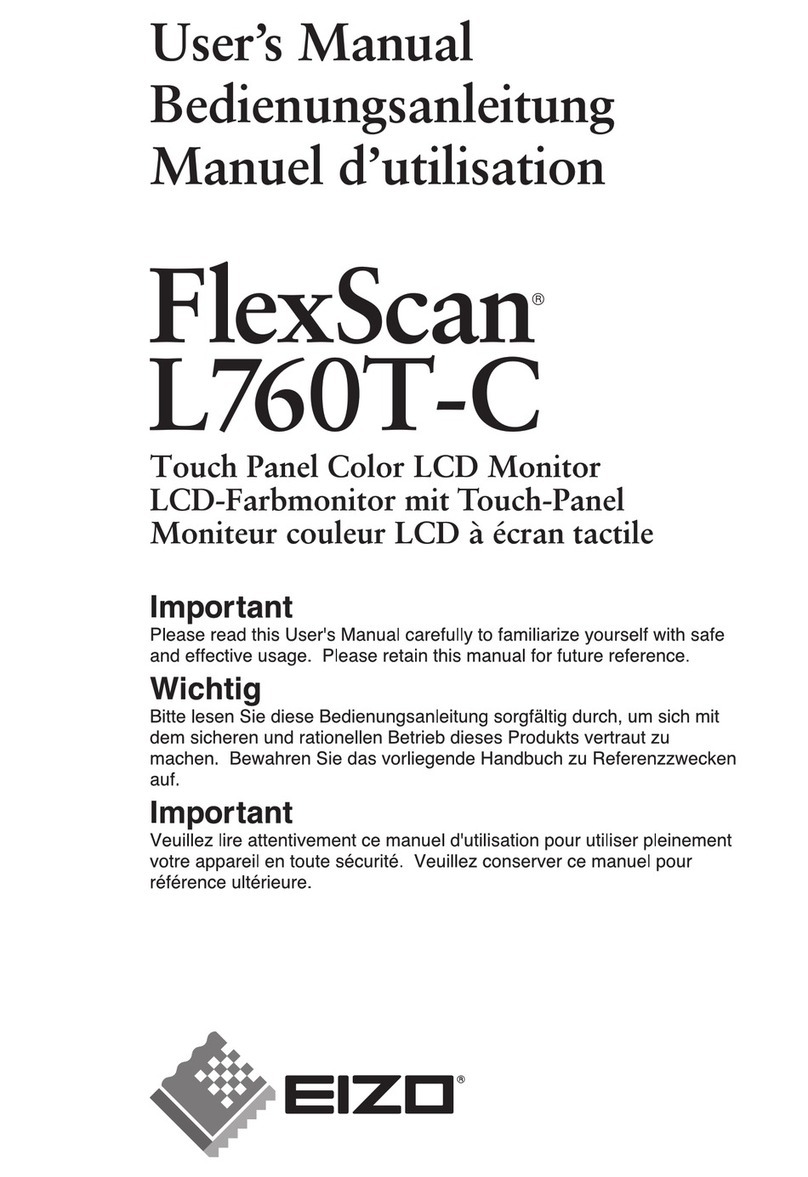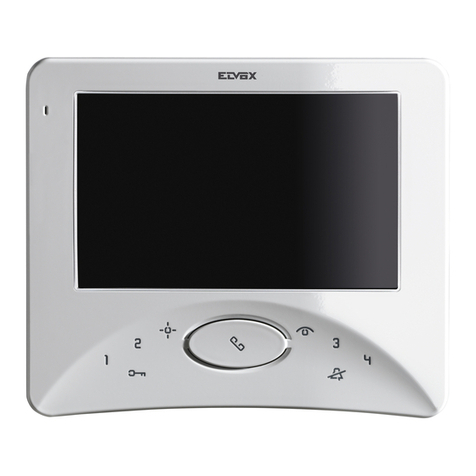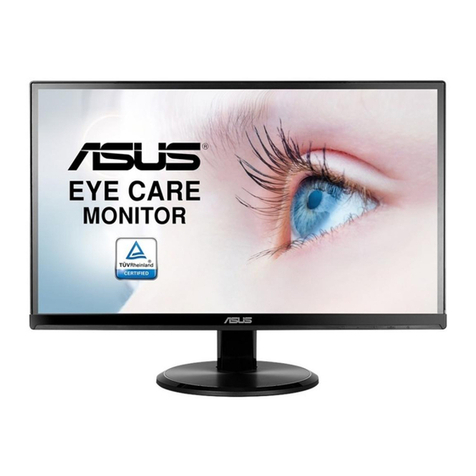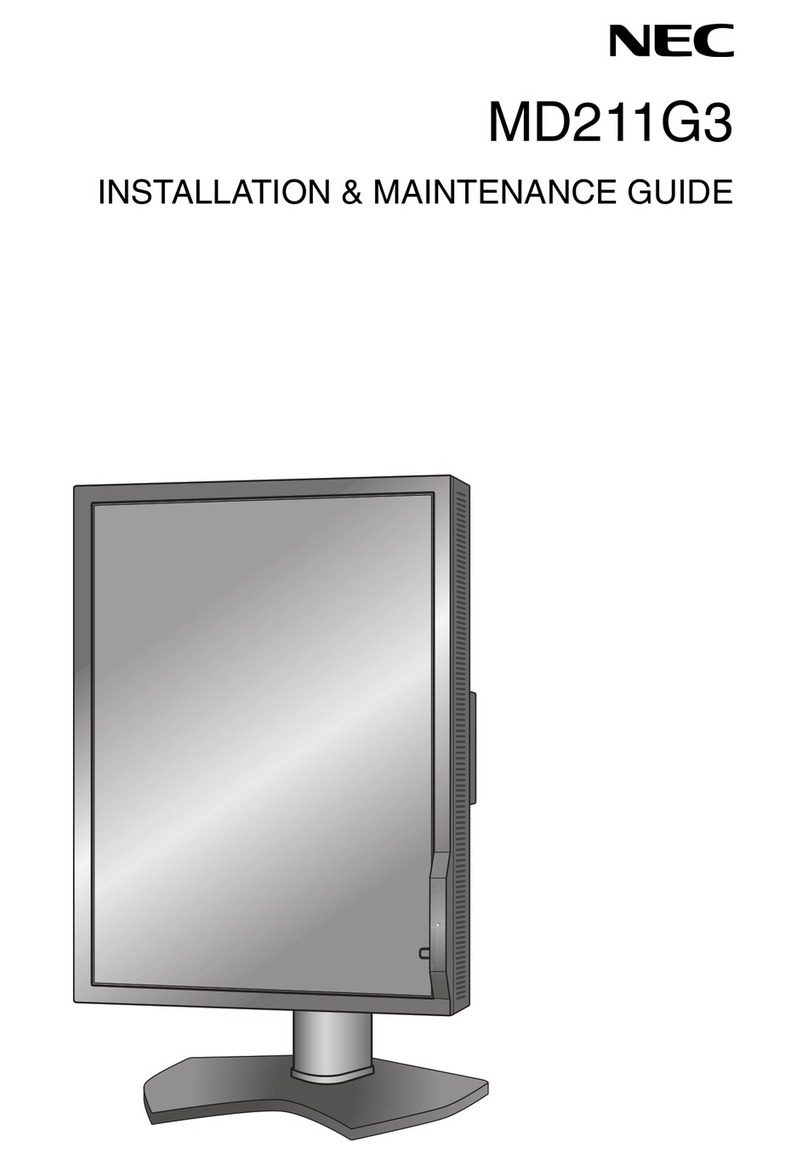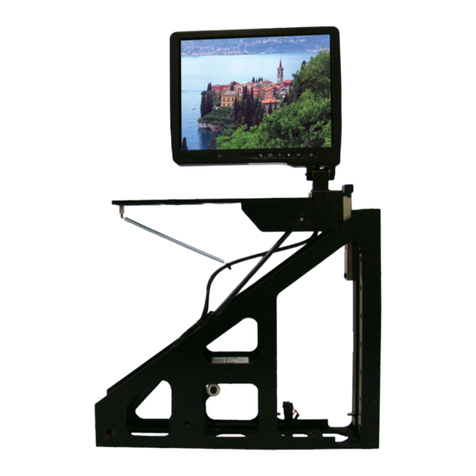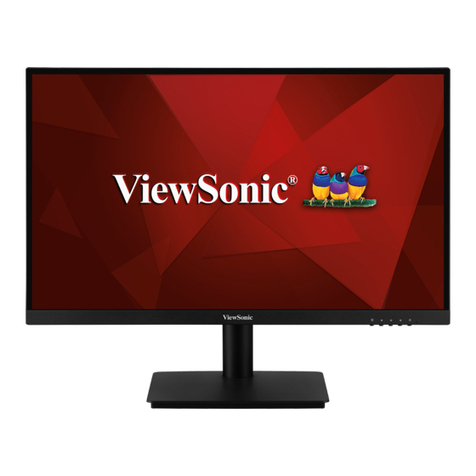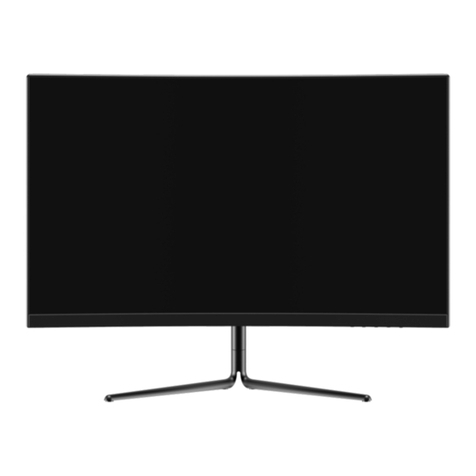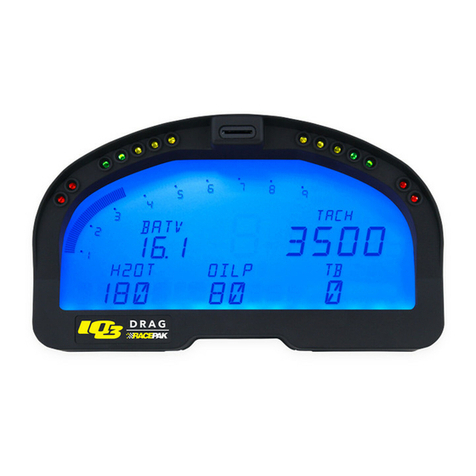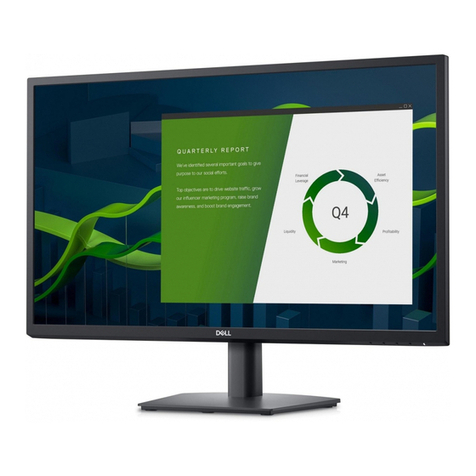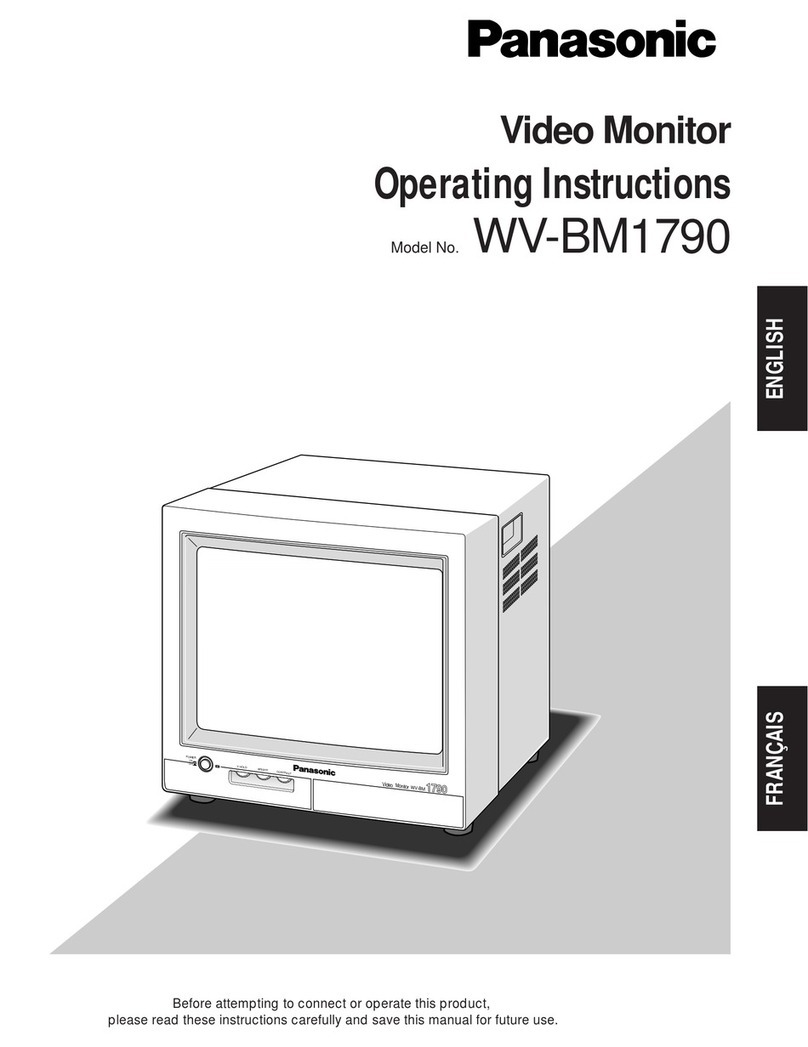ELKHART BRASS Scorpion RF 8294-06 Assembly instructions

8294-06, 8294-06 EXT, & 8394-07 Monitors
Installation, Operating, & Maintenance Instructions
98291000 REV. K
1-574-295-8330
www.elkhartbrass.com

2
TABLE OF CONTENTS
PRODUCT SAFETY INFORMATION 3
MONITOR CALLOUT DRAWING 4
SYSTEM COMPONENTS 5
INSTALLATION INSTRUCTIONS 9
Installation Step 1: Mount and Wire all System Components 9
Installation Step 2: Communication Address Setup 12
Installation Step 3: RF Settings Setup 13
Installation Step 4: System Programming 15
OPERATING INSTRUCTIONS 18
MAINTENANCE INSTRUCTIONS 21
SYSTEM SPECIFICATIONS 24
COMPONENT MOUNTING TEMPLATES 25
To view the most current parts list and drawings please visit www.elkhartbrass.com

3
PRODUCT SAFETY INFORMATION
All personnel who may be expected to use this equipment must be thoroughly trained in
its safe and proper use.
Before flowing water from this device, check that all personnel (fire service and civilian)
are out of the stream path. Also, check to make sure stream direction will not cause
avoidable property damage.
Become thoroughly familiar with the hydraulic characteristics of this equipment, and the
pumping system used to supply it. To produce effective fire streams, operating personnel
must be properly trained.
Whenever possible, this equipment should be operated from a remote location. Do not
needlessly expose personnel to dangerous fire conditions.
Open water valves supplying this equipment slowly so that piping fills slowly, thus
preventing possible water hammer occurrence.
After each use, and on a scheduled basis, inspect equipment per instructions in the
Maintenance section.
Any modifications to the electrical enclosures will destroy the NEMA 4 rating and void
warranty coverage of the enclosure and all components within.
Important: Before installing and operating provided equipment, read this manual
thoroughly. Proper installation is essential to safe operation.
SYSTEM INFORMATION:
MONITOR SERIAL NUMBER:________________________________________________________
MONITOR ACCESSORIES (NOZZLE GALLONAGE AND TYPE, TYPES OF TRANSMITTERS, WATER
VALVE, ETC.):
__________________________________________________________________________________________
__________________________________________________________________________________________
__________________________________________________________________________________________
__________________________________________________________________________________________
__________________________________________________________________________________________
__________________________________________________________________________________________
__________________________________________________________________________________

4
MONITOR CALLOUT DRAWING
Optional SM-2000E
Electronically Actuated Nozzle
Fully Vaned Cast
Aluminum or Brass
Waterway
Manual Override Sealed High-
Torque Gearmotor
8294-06 Scorpion RF Monitor
284A Stream Shaper
3.5” NHT Discharge
Pressure Gauge
RF Receiver/Control Module
4” 150# ANSI Flange

5
SYSTEM COMPONENTS
MONITOR
Scorpion RF Monitors – 8294-06 & 8394-07
The 8294-06 and 8294-06 EXT is a cast aluminum monitor with 4”
waterway while the 8394-07 is cast brass. The waterway contains
a central vane to minimize large-scale turbulence and provide
superior fire streams. Monitor water supply connection is a 4 inch
150 lb. ANSI pattern flange. The discharge nozzle connection is
3½” National Hose thread. Nozzle stream direction is controlled
by two permanent magnet type planetary gear motors, one
controlling rotation about the axis of the water inlet, and the
other controlling nozzle elevation and depression. Right angle
gear cases between the gear motor and the monitor allow for
convenient manual override of the electric motors in the event
of a power failure during firefighting operations. All gearing is
enclosed within the monitor housings.
Scorpion RF Monitor – 8294-06 EXT
The extended travel Scorpion has the same highly efficient
waterway and flow capacity as the Scorpion RF monitor. The
monitor waterway is supplied through a 4” 150# flat faced
flange base. The 8294-06 EXT monitor has a mechanical stop to
allow 180° for added protection in an aerial application.
The extended travel Scorpion RF has special
features to optimize performance as an aerial
master stream device when used on a straight
aerial ladder with pinnable waterway. The
pinnable waterway feature allows the waterway
to be pinned to the second fly section of the
ladder (egress position), thus keeping the monitor
and nozzle away from the end fly section when it
is necessary to place the ladder tip at a window
sill or roof parapet.
The 8294-06 EXT contains a special wiring harness connection at the inlet flange to allow
attachment of an OEM provided proximity sensor. The proximity sensor is used to tell the
monitor controller which positions the waterway and monitor is. As a result, the monitor
discharge Up-Down travel range differs for the two waterway and monitor positions as
indicated in Table 1.
Waterway/Monitor
Position
Up-Down Travel Range
Master Stream +30° to -135°
Egress +0° to -135°
Table 1: EXT Travel Ranges
The 0° position is when the nozzle is aimed parallel to the ladder.

6
As a further enhancement, the left-right motor direction of rotation automatically reverses
when the monitor discharge is in the range of 0° to +30°. Without this feature, when the
discharge travels above 0°, “left” would functionally become “right” and vice versa.
If the proximity sensor changes state while the monitor is in the “master stream” position and
the monitor discharge is in the 0° to 30° “up” range, the monitor controller will automatically
lower the discharge to 0° to prevent possible interference with the ladder, or impingement of
stream upon personnel.
Caution: All monitor motors are 12VDC. If using a non-Elkhart nozzle, another 12VDC
nozzle should be used, or nozzle control may not function properly.
NOZZLE
Scorpion RF Nozzles –
There are two nozzles available for the Scorpion RF.
SM-1250E & SM-2000E
The maximum monitor flow capacity is 2000 gallons per
minute. Monitors can be supplied with the SM-1250E
(SM-1250BE for model 8394-07) constant pressure
(automatic) type master stream nozzle. This nozzle has
a flow range of 300 to 1250 gallons per minute at 75 psi
and has an electric drive mechanism for RF control of
the spray pattern from a straight stream to wide fog.
A similar nozzle, the SM-2000E (SM-2000BE for 8394-07), provides a flow range of 500 to 2000
gallons per minute at 80 psi. For optimum straight stream performance, stream shapers are
provided as part of the monitor and nozzle system. Solid stream nozzles are also available for
use with these monitors.
SM-1250E; 350 GPM @ 50 PSI – 1250 GPM @ 75 PSI
SM-2000E; 500 GPM @ 50 PSI – 2000 GPM @ 80 PSI
CONTROL
Handheld RF Controller – 81282001
A sealed handheld RF transmitter contains all the controls
necessary for operation of the monitor. The handheld remote
allows the operator to direct the monitor from a significantly
improved point of view. With the wireless remote, the operator
can view the stream from the side and confirm that the stream is
hitting its target. Separate push button switches are provided for
up, down, left, right, fog, and stream functions. The handheld
remote has user selectable frequency and security codes that
allow multiple monitors to operate on the same fire ground at
the same time. The remote has an automatic power down
SM-1250E (P/N: 03781211) &
SM-2000E (P/N: 03990201)

7
feature that will shut down the power after 5 minutes of no
activity. As an additional power saving feature the radio signal is
only transmitted while a button is pushed. The handheld remote
case has a NEMA 4 rating.
Primary Panel Mount RF Controller – 81327101
The fixed RF transmitter sends signals to the monitor via an
encoded radio signal, requiring no wires between the RF
transmitter and the monitor. It is powered by the vehicle
electrical system. The faceplate is intended for a flush mount
onto the pump or aerial ladder control panel. Separate sealed
push button switches are provided for up, down, left, right, fog,
and stream functions. This fixed RF transmitter provides two-
button access to the Stow feature. It will override any low-priority
controls, allowing the apparatus operator to retain ultimate
control over the monitor. Comes with 10 foot coax antenna
cable and (1) 90° antenna and (1) straight antenna.
Secondary Panel Mount RF Controller – 81327201
The fixed RF transmitter sends signals to the monitor via an
encoded radio signal, requiring no wires between the RF
transmitter and the monitor. It is powered by the vehicle
electrical system. The faceplate is intended for a flush mount
onto the pump or aerial ladder control panel. Separate sealed
push button switches are provided for up, down, left, right, fog,
and stream functions. Comes with 10 foot coax antenna cable
and (1) 90° antenna and (1) straight antenna.
Caution: Any modification of the Handheld Controller or Panel Mount enclosures will
destroy the NEMA 4 rating to that piece of equipment and will void the warranty
coverage.
MONITOR ACCESSORY
Primary OEM RF Transmitter – 81353101
The OEM RF transmitter allows the monitor installer to use their
switching arrangement while still having the benefit of the W.E.T.
It has all of the same features of the Primary Panel Mount RF
controller, but has a wiring harness for the installer to connect to
the switches. Comes with 10 foot coax antenna cable and (1)
90° antenna and (1) straight antenna.
Secondary OEM RF Transmitter – 81353201
The OEM RF transmitter allows the monitor installer to use their
switching arrangement while still having the benefit of the W.E.T.
It has all of the same features of the Secondary Panel Mount RF

8
controller, but has a wiring harness for the installer to connect to
the switches. Comes with 10 foot coax antenna cable and (1)
90° antenna and (1) straight antenna.
Secondary Switch Box Control for Aerial Application –
81549001
This component is a surface mount type switch box with controls
for operation of the monitor for use with the OEM secondary RF
transmitter. Separate sealed toggle switches are furnished for
up-down, left-right, and strt-fog functions. The box has a NEMA 4
rating, and is generally installed at the tip of the aerial ladder, or
in the bucket of the aerial platform. A terminal strip inside the
enclosure allows for connection of the control cable, and a
watertight strain relief fitting provides for sealing around the
cable entry
Auxilary Battery Pack – 81492001
A 12-volt, 12 amp-hr. sealed lead-acid battery pack is available
to allow operation of the monitor in case of vehicle electrical
system failure. These battery packs are also used as a means to
minimize the required size of conductors routed up aerial ladders
and towers. This is accomplished by mounting the battery pack
near the monitor, with a small trickle-charge conductor to the
battery from the vehicle system
Caution: Any modification of the enclosures of any of the transmitters or switch box
will destroy the NEMA 4 rating, and will void the warranty coverage. Ensure all O-ring
and gaskets are properly installed when closing receiver or controller enclosures.
DC to DC Converter Function – 24272000
An optional 24 to 12VDC converter board can be added to the RF receiver control module
to allow 24 VDC power to the monitor. The converter will supply enough 12VDC power to
the monitor to run all motors simultaneously. It is reverse voltage protected and meets SAE
J1113-11 (Immunity to Conducted Transients on Power Leads) requirements.

9
INSTALLATION INSTRUCTIONS
Installation Overview:
Installation Step 1: Mount and Wire All System Components
Warning: It is up to the system designer to appropriately handle the open circuit
condition of the stow signal. In the open circuit mode there is no source to turn off the
stow signal load, which may lead to erroneous signal indications if not handled properly.
The stow signal is capable of sinking 250mA maximum. Exceeding this value may blow
the intern
al fuse and the stow output will no longer be able to provide a ground.
Important: Most test lights draw in excess of 1A.
Monitor Mounting –
4” NPT Base: Thread monitor onto male 4” NPT thread using Loctite 592 or equivalent
thread sealant. Install the monitor in the straight ahead position.
4”-150# Flat Faced Flange: Attach 4”-150# ANSI
pattern companion flange to water supply pipe so
that the bolt pattern will allow the monitor to be
installed in the straight ahead position. Alignment is
correct when the straight ahead position is centered
between adjacent flange holes. Attach monitor inlet
flange to companion flange on water supply pipe
with eight (8) 2½” 5/8-11 UNC grade 5, carbon steel
or stainless steel bolts & nuts. Seal flange joint with
gasket, or suitable flange sealant. Most wafer type
butterfly valves have seats that serve as flange
gaskets, and separate gaskets or sealant is not
required. Apply Loctite 242 or equivalent to bolt
threads before tightening nuts. Torque to 60-70 ft-lbs.
Warning: When installing the monitor on a raised face companion flange, it is critical
that the bolts be tightened uniformly to prevent misalignment of the monitor relative to
the flange or valve. If the monitor becomes misaligned, the base flange will fracture and
fail when the bolts on the “high” side are tightened.
Step 1 – Mount and Wire All System
Components
Step 2 – Communication Address Setup
Step 3
–
RF Settings Setup

10
Monitor Wiring –
Crimp a fused lead from a switched positive power source to the red lead (pin C) of
the power harness supplied. Use a 10A fuse for the 8294-06 & 8294-06 EXT, and a 15A
fuse for the 8394-07. Crimp a lead from the vehicle ground to the black lead (pin A) of
the monitor power harness. Shrink and seal the connectors with a heat gun after
crimping.
The white lead (pin B) is for an optional “Stow Indicator” which could be attached to a
relay or LED supplied by the OEM. The circuit switches in a ground when the monitor is
in a non-stowed position.
All control functions are sent to the monitor via an encoded RF signal from the RF
controller, and no control wiring is needed.
The 8294-06 EXT has a proximity sensor. The red wire (pin C) supplies power, the black
lead (pin A) is the ground, and the white lead (pin B) is the signal for the proximity
sensor to show master stream versus an egress position.
Panel Mount RF Controllers –
Using the Panel Mount RF Controller template in the Component Mounting Templates
section, mark the panel cutout and mounting screw locations.
Cut a rectangular clearance opening and drill four (4) 7/32” holes.
Insert fixed RF controller case through the panel cutout. Secure the unit to the panel
with four (4) #10-32 screws. The length of the screws should be the panel thickness plus
3/16”. The screws supplied are ¼” in length. Apply Loctite 242 or equivalent to screw
threads before tightening them.
The controller antenna is to be mounted using the 10’ antenna cable provided.
Locate one of the antennas outside the vehicle compartment, and in a position that
provides the least obstructed line of sight to the monitor’s antenna.
Place a 1A fuse between the red lead of the RF controller and a switched positive
power lead on the vehicle. Attach the black lead from the monitor base to the
vehicle ground.
All control functions are sent to the monitor via an encoded RF signal from the RF
Controller.
OEM RF Transmitter –
Place a 1A fuse between the red lead of the transmitter and a switched positive
power lead on the vehicle. Attach the black lead from the monitor base to the
vehicle ground.
Connect all of the switch commons to the ground (black) connection.
Connect each function to a corresponding switch (see Table 2 on page 11). To
operate the function, close function’s switch to ground. Any combination of
pushbuttons or toggle switches can be used.

11
Power indication can be created by attaching an LED and proper resistance between
the VCC (+3V) and ground connections. Max rating for the VCC connection is 250mA.
The transmitter’s antenna is to be mounted using the 10’ antenna cable provided.
Locate one of the antennas outside the vehicle compartment, and in a position that
provides the least obstructed line of sight to the monitor’s antenna.
Table 2: OEM RF Transmitter switches
Secondary Switch Box Control for Aerial Applications –
Using the Secondary Control Switch Box template in the Component Mounting
Templates section, mark the mounting holes on panel or bracket.
Drill two 9/32” diameter holes in panel or bracket.
Remove ¼-20 screws and lock washers from back of box. Insert screws with lock
washers through backside of panel or bracket into mounting holes in box. Tighten
screws.
Auxiliary Battery –
Using the Auxiliary Battery template in the Component Mounting Templates section,
mark locations of mounting holes on mounting surface or bracket.
Drill four (4) 21/64” diameter mounting holes.
Open hinged cover of battery enclosure by loosening the four screws. Insert one 5/16-
18 UNC socket head cap screw from the inside of the enclosure through each of the
four (4) mounting holes of the enclosure and into the corresponding holes in the
mounting surface or bracket. Assemble nuts and lock washers to each mounting
screw, then tighten.
Function Wire Color
Ground Black
VCC (+3V)
Output Red
Right Brown
Down Orange
Up Yellow
Left Green
Stream Blue
Fog Violet
Aux 2 Grey
Oscillate White
Aux 1 White/Black
Stow White/Brown

12
Plug the female connector of the battery pack into the male connector at the base of
the monitor.
Crimp a fused positive power lead from the vehicle charging system to the read lead
(pin C) of the power harness supplied. Use a 10A fuse for the 8294-06 & 8294-06 EXT,
and a 15A fuse for the 8394-07. Crimp a lead from the vehicle ground to the black
lead (pin A) of the monitor power harness. Shrink and seal the connectors with a heat
gun after crimping. Plug the female connector of the finished harness into the male
connector of the battery pack.
The white lead (pin B) is for an optional “Stow Indicator,” which can be attached to a
relay or LED supplied by the OEM. The circuit switches in a ground when the monitor is
in a non-stowed position.
Installation Step 2: Communication Address Setup
An RF Controller controls one 8294-06, 8294-06 EXT, or 8394-07 monitor. The controller is
digitally encoded with a security code ensuring that it does not accidentally control the
wrong monitor. The receiver has a matching decoder and security code that instantly
decodes and interprets commands. The security code is a 15-bit selectable code that is set
on both the remote transmitter and receiver.
The 8294-06, 8294-06 EXT, and 8394-07 monitors are tested and shipped with a security code
based upon the monitor serial number, ensuring each monitor leaves the factory with a
unique code assigned to it. The security settings will normally not need to be changed. In the
case of a lost transmitter or replaced control board, contact Elkhart Brass.
Danger: Using two W.E.T. monitors with the same security code may cause the
inadvertent control of the wrong monitor, resulting in possible property damage and
injury to personnel. Using the factory specified codes will help prevent this.
Caution: Do NOT pinch wires when attaching back panel to front panel of the
handheld enclosure. Ensure all O-rings and gaskets are properly installed when closing
the receiver or transmitter enclosures.
Important: The RF Receiver/Control Module and all transmitter communication
addresses have been factory set. The
y
should not require any additional address setup.

13
Installation Step 3: RF Settings Setup
RF Receiver/Control Module Settings –
Remove the cover from the RF Receiver/Control Module. SW4 (see Figure 1) allows this board
to be used in different product applications. In order for it to properly operate the Scorpion
RF monitor, it must be set to one of the following positions:
1 8294-06 & 8394-07 Scorpion RF – Blinking Stow Indicator for Dash Panel Indicator
Application
2 8294-06 & 8394-07 Scorpion RF – Non-blinking Stow Indicator for Interlock
Application
A
8294-06 EXT Scorpion RF
If it is set to a value that is not yet programmed, the status indicator LED, DS5 (see Figure 1),
will blink rapidly until a valid setting is selected AND power is cycled. If SW4 is set to a valid
setting but not one of the above positions, unpredictable results will occur.
Figure 1: RF Receiver/Control Module Circuit Board
Handheld RF Controller Settings –
Remove the battery cover from the handheld RF controller. Remove the four (4)
screws holding the two halves of the cover together using a #1 size Pozidriv®
screwdriver (use caution with a standard Philips screwdriver as it may strip the screw
heads).
Locate the security code switches on the circuit board (see Figure 2 on page 14).
Change the switches to match the settings of the RF Receiver/Control Module except
switch A position 1. One incorrect setting will prevent the system from working
properly.
Ensure the battery lead connector is securely fastened to the transmitter circuit board.
When reassembling the handheld controller, ensure that no wires will be pinched,
close the cover halves, and replace the screws. Do not exceed 6 in-lbs. of torque. The
screws should be just snug. Do not over tighten the screws or the plastic enclosure
could strip.
With the monitor power on, turn on the handheld controller. The PWR/XMIT light will
flash. Once the flashing light stops (light will be off), turn the handheld on once again.
DS5
DS2
B
A
DS1
SW4
SW1
DS4
P2
DS3
P3
DS6
P1
P4
SW2
SW3
Status LED
SW4

14
This can take 3-5 minutes and is required to sync the handheld to the monitor. The
handheld is now ready for use.
Figure 2: Handheld RF Controller Circuit Board
Caution: Do NOT change switch A position 1 on any transmitter. This switch is used
to set the priority setting of the transmitter and changing this switch may remove
override capabilities.
Panel Mount RF Controller and OEM RF Transmitter –
Disconnect the power connector to the panel mount controller at the back of the
panel.
Open the back cover of the controller after loosening the screws.
Remove the red and black power leads from the power conversion board and place
the cover to the side.
Locate the security code switches on the circuit board (see Figure 2).
Change the switches to the settings of the RF Receiver/Control Module except switch
A position 1. One incorrect setting will prevent the system from working.
Reconnect the power leads. The red lead is attached to the Positive (+) terminal, and
the black lead is attached to the Negative (-) terminal.
Close the cover and replace the screws.
Reconnect the power connector.
Important: While reassembling the controller or transmitter, ensure wires and
antenna leads do not become pinched.

15
Installation Step 4: System Programming
Programming Stow Position
8294-06 & 8394-07
On the monitor receiver board switch A position 1 “ON” is stow up, while switch A
position 1 “OFF” is stow down. If any selections are changed, power must be cycled.
Move the monitor to the left or right position that will be used for stowing the monitor.
Press and hold the red programming switch, SW1 (see Figure 3), for approximately 5
seconds, then release.
The monitor will move up or down (depending on the location of switch A position 1
on monitor receiver board), and rotate to the left until the stop is located.
When the monitor stops, the programming will be complete.
If the programming is interrupted by inadvertently pressing the SW1 (red) button or any
button on the primary or secondary controller, a programmed stop is set, and will not
allow movement past this point. The programmed stops can be cleared by holding the
red SW1 button for 3 seconds and allowing the monitor rotate to the left stop. After this
is complete, repeat the above procedure.
On the primary controller, press and hold the Stow and Fog buttons for 5 seconds to
activate and check the stow positioning.
8294-06 EXT
The 8294-06 EXT monitor does NOT allow for user selectable stow position.
Press and hold the red programming switch, SW1, for a minimum of 5 seconds. After
the red programming button is released, the monitor will travel to both the left and
right travel limits in order to calibrate the horizontal stow position at ZERO (straight
ahead).
Activating the stow function will cause the monitor to rotate to the straight-ahead
position with the discharge at 0 degree elevation.
Figure 3: SW1 Switch
Caution: To prevent damage to the monitor controller, keep all metallic objects away
from the receiver circuit board while it is energized. Ensure all O-rings and gaskets are
properly installed when closing receiver
enclosure.
DS5
DS2
B
A
DS1
SW4
SW1
DS4
P2
DS3
P3
DS6
P1
P4
SW2
SW3
Red
Programming
Button (SW1)

16
VERTICAL TRAVEL STOP IS FACTORY
SET AT 90 ABOVE TO 45 BELOW
HORIZONTAL
STOP SCREWS ARE FACTORY
INSTALLED AT THESE LOCATIONS.
(180 HORIZONTAL TRAVEL.)
Rotational Limit Settings
8294-06
The rotational stop screws (see Figure 4) set the monitor rotational limits (left-right and
up-down) to satisfy the application requirements, as well as NFPA* requirements. The
monitor is shipped from the factory with the horizontal travel limits set at 90 degrees left
and 90 degrees right of the zero (straight ahead) position. The vertical travel limits are
factory set at 90 degrees above, and 45 degrees below horizontal. If the application
requires the rotation limits to be changed, relocate threaded stop screws to required
positions per chart below. Apply Loctite 242 or equivalent to stop screws and hex
head plugs prior to reinstalling (stop screw holes are identified on the monitor by a
stamped letter adjacent to each hole). All empty stop screw holes should be filled with
a hex head plug.
8394-07
The rotational stop screws (see Figure 4) set the monitor rotational limits (left-right and
up-down) to satisfy the application requirements, as well as NFPA* requirements. The
monitor is shipped from the factory with the horizontal travel limits set at 90 degrees left
and 90 degrees right of the zero (straight ahead) position. The vertical travel limits are
factory set at 90 degrees above, and 45 degrees below horizontal. If the application
requires the rotation limits to be changed, relocate threaded stop screws to required
positions per chart below. Apply Loctite 242 or equivalent to stop screws and hex
head plugs prior to reinstalling (stop screw holes are identified on drawing 98031050).
All empty stop screw holes should be filled with a hex head plug
8294-06 EXT
Monitor can be rotated 90° left or 90° right of the zero (straight ahead) position. The
vertical travel is either Master Stream (+30 to -135°) or Egress (+0° to -135°). Horizontal
travel limits can NOT be changed.
Monitor can be rotated 90° left or 90° right of straight ahead. Stops are mechanically
fixed by a stop screw and milled slot in base. Stop screw must remain in place in
monitor base.

17
Figure 4: Scorpion RF Rotational Stops
Caution: At least one stop screw is required to prevent damage to the monitor. If the
monitor is set with the horizontal setting at 174 degrees left or right of the zero (straight
ahead) position, the vertical setting will need to be set to 30 degrees below horizontal as
the maximum
lowest position.
Table 3: Horizontal Settings (8294-06 only)
Application Rotation Limits
Stop
Screw
Locations
Aerial Ladder,
Elevating
Platform, Water
Tower
45° Left or Right of Straight Ahead D & H
67½° Left or Right of Straight Ahead E & G
90° Left or Right of Straight Ahead F
Deck Gun 174° Left or Right of Straight Ahead A
Table 4: Vertical Settings (8294-06 only)
Application Rotation Limits
Stop
Screw
Locations
Aerial Ladder,
Deck Gun
90° above horizontal to 45° below
horizontal T
Elevating
Platform
45° above horizontal to 45° below
horizontal T & U
To view a complete list of stops, please download the Scorpion Monitor Position Chart
(98031010 for 8294-06, and 98031050 for 8394-07) from www.elkhartbrass.com.
Table 5: NFPA 1901, 2003 Ed. minimum rotation angles for aerial device monitors.
20.6 Aerial Ladder Water Delivery System
20.6.1.3.1 The monitor shall be capable of swiveling at least 135° from a line parallel to
the ladder and down.
20.6.1.3.2 The monitor shall be capable of horizontal traverse at least 45° from each
side of center.
20.12 Elevating Platform Water Delivery System

18
20.12.3.2
The monitor(s) shall allow the operator to control the aimed direction of the
nozzle through a rotation of at least 45° on either side of center and at least
45° above and below horizontal.
20.12.3.3 The horizontal and vertical traverse of the monitors shall not exceed the
elevating platform manufacturer’s recommendation.
OPERATING INSTRUCTIONS
Normal Operation
The Scorpion monitors use the standard Left/Right, Up/Down, and Fog/Stream commands to
provide stream direction and pattern adjustments.
To move the monitor left or right, press and hold the LEFT or RIGHT button until the
monitor discharge is in the correct position, or a mechanical stop is reached.
To move the monitor up or down, press and hold the UP or DOWN button until the
monitor discharge is in the correct position, or a mechanical stop is reached.
To adjust the stream pattern, press and hold the FOG or STREAM button until the
desired stream pattern is reached.
Any combination of left or right, fog or stream, and up or down can be used to achieve
motion horizontal, vertical, or nozzle commands simultaneously. If the LEFT and RIGHT
buttons are pressed at the same time, the monitor will stop all motion. To continue motion,
release both buttons and repress the desired direction button. This is also true for the
up/down and fog/stream commands.
The handheld remote transmitter has a power saving feature that turns the transmitter power
off if no signal is sent for 5 minutes. Press and hold the “ON/OFF” button until the Power LED
illuminates to reactivate the transmitter. The “Low Battery” LED will flash slowly when the
battery voltage drops below a predetermined level. When the low battery LED flashes
rapidly, the batteries are nearly discharged and should be replaced immediately.
NOTE: The SM-1250E, SM-1250BE, SM-2000E and SM-2000BE nozzles have a unique ball screw
drive that allows motor to “free wheel” at the end of pattern travel in either the straight
stream or wide fog positions. No slip clutch or current limiting feature is used with these
nozzle drives.
Oscillation Function
The 8294-06, 8294-06 EXT, and 8394-07 monitors have an automatic left/right oscillation
function, which can be used to provide continuous exposure protection with no operator
input. The oscillation limits are set using the handheld or truck mount RF transmitters.
Position the monitor at either the left or the right limit of oscillation.
Press and hold the OSCILLATE button.
Move the monitor to the other limit of oscillation.
Release the OSCILLATE button.

19
Press and release the OSCILLATE button to engage the oscillation function.
The monitor will oscillate between the limits until the oscillation button is pressed again.
Pressing the left or right button on one of the controllers will also stop the oscillation.
For safety reasons, once oscillation has stopped the oscillation limits need to be
reprogrammed before it can be re-engaged. The nozzle fog, stream, and discharge
elevation functions can be operated while the monitor is oscillating.
Manual Override
In the event of power failure to the monitor, the motors may be actuated manually. To
operate a function manually, simply apply a ¾” ratcheting type wrench (either socket type
or ratcheting box end type) to the hex fitting on the motor shaft.
Important: Using the horizontal override nut when the power to the receiver is off or
the horizontal motor is disconnected will move stow position from its original
programmed position. See section titled Programming Stow Position to realign stow
position
even if stow feature is not utilized.
Warning: Do NOT use impact drivers to operate the manual override nuts. Serious
damage to motor gear heads will occur.
Storing the Monitor
Elkhart Brass recommends that a stow position be set and the stow routine be utilized to
place the monitor in its stowed position after each use.
8294-06 & 8394-07
These monitors have a user selectable stow position (see Programming Stow Position
section for instructions). After the water supply to the monitor has been turned off,
simultaneously press the STOW and FOG buttons on the primary panel mount RF
transmitter (buttons must be held down for a minimum of 3 seconds). The monitor will
automatically rotate horizontally to the stow position previously programmed, and
either lower or raise the discharge to its mechanical stop (depending on the position
of switch A position 1 on the receiver board). Prior to stowing the monitor, the stow
signal output provides a ground signal. There are two settings for stow signal output.
Switch 4 Position 1 (Signal Mode)
Once the monitor starts to move to the stow position, the stow signal output will
alternately supply and remove the ground, at approximately a 1 second rate, while
the monitor is moving to the stow position. Once the monitor has completed the stow
sequence, the stow signal output will be an open circuit.
Switch 4 Position 2 (Interlock Mode)

20
Once the monitor starts to move to the stow position, the stow signal output will
continue to supply a ground while the monitor is moving to the stow position. The
ground will be removed after the monitor reaches the stow position and the stow
signal output will be an open circuit.
NOTE: If the stow indicator does not turn off, see the Programming Stow Position
section to realign the stow position. Provided the necessary switches are wired, the
OEM primary transmitter will operate using the same inputs as listed for the primary
panel mount transmitter.
Any directional command (left, right, up, down, fog or straight stream) will cancel the
stow command, and the stow output signal will continue to provide a ground. To stow
the monitor, the stow command must be reactivated.
8294-06 EXT
The 8294-06 EXT aerial monitor does not allow for a user selectable stow position, switch
SW4 should be set to position A for this application. After the water supply to the
monitor has been turned off, simultaneously press the STOW and FOG buttons on the
primary panel mount RF transmitter (buttons must be held down for a minimum of 3
seconds). Activating the stow function causes the monitor to rotate horizontally to the
center of the allowed travel and move the discharge to 0° elevation. As the monitor
starts to move to the stow position, the stow signal output will continue to supply a
ground while the monitor is moving to the stow position. The ground will be removed
after the monitor reaches the stow position and the stow signal output will be an open
circuit.
Any directional command (left, right, up, down, fog or straight stream) will cancel the
stow command, and the stow output signal will continue to provide a ground. To stow
the monitor, the stow command must be reactivated.
Warning: Never activate the stow feature while water is flowing. Serious injury to
personnel and damage to apparatus could result.
Warning: It is up to the system designer to appropriately handle the open circuit
condition of the stow signal. In the open circuit mode there is no source to turn off the
stow signal load, which may lead to erroneous signal indications if not handled properly.
The stow signal is capable of sinking 250mA maximum. Exceeding this value may blow
the internal fuse and the stow
output will no longer be able to provide a ground.
Important: Most test lights draw in excess of 1A.
Other manuals for Scorpion RF 8294-06
1
This manual suits for next models
2
Table of contents
Other ELKHART BRASS Monitor manuals




